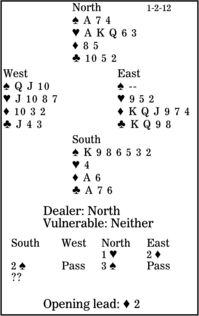Bridge column, January 2: Hand evaluation is undervalued

Take today's South hand. North opens one heart, East overcalls two diamonds, South responds two spades, and North raises to three spades. What should South do now?
Also, how should South play in six spades after a diamond lead?
North's three-spade rebid showed a minimum opening; with extra values he would have jumped to four spades. The South hand, though, despite having only a minimum opening in point-count terms, is very strong because of the 10- or 11-card fit, two aces, a potentially useful singleton and only five losers (deducting one for the excellent fit). However, to launch immediately into Blackwood would be a tad -- but only a tad -- optimistic. South should suggest a slam to partner by rebidding four clubs, which is a control-bid (cue-bid) showing that ace.
North has a slam-suitable hand with an excellent suit. He should control-bid four hearts. Now South could just bid six spades -- real bridge players don't use Blackwood!
South should win the diamond lead and cash his spade king. When he sees the 3-0 break, he plays off dummy's three heart honors, discarding one diamond and one club, and ruffs a heart in his hand. (It wouldn't matter if West could overruff.) Dummy is entered with a spade to the ace, and South's remaining low club is discarded on the last heart.
** ** **
COPYRIGHT 2012, UNITED FEATURE SYNDICATE
DISTRIBUTED BY UNIVERSAL UCLICK FOR UFS

